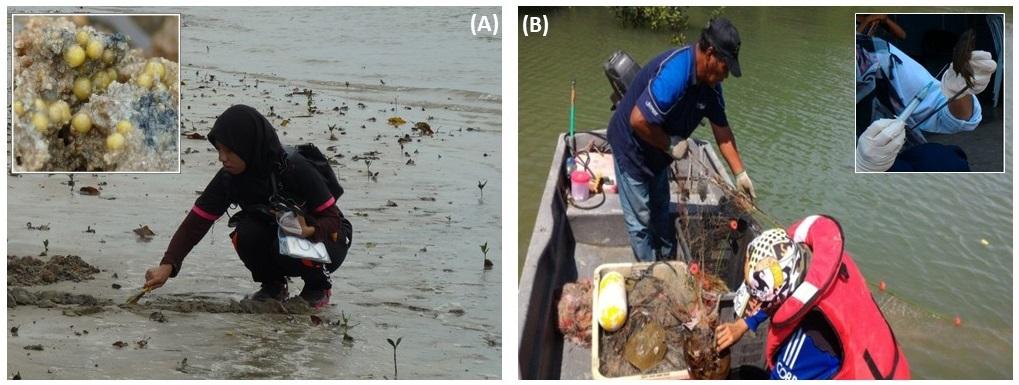The East-West differentiation for both marine and estuarine flora and fauna in Peninsular Malaysia is a well-known and immensely documented phenomenon explained from the Sunda shelf flooding during the Holocene. However, precise geographic location of the genetic break as well as potential contact zones of the migrating animals between South China Sea and Malacca Strait remains unexplored.
During the global de-glaciation period, the flooding of the Sunda shelf facilitated mangrove species range shift towards the East and West coasts of Malay Peninsula. Currently, Peninsular Malaysia has ca. 110,952 ha of mangrove cover of which nearly 17,570 ha (3%) distributed along the East coast and 93,382 ha (15%) on the West coast. The horseshoe crabs that existing since 450 million years are commonly called as living fossils. Among the three Asian horseshoe crab species, Carcinoscorpius rotundicauda (Latreille, 1802) is known as a mangrove horseshoe crab due to its preference to live and nest close to mangrove habitats (Fig. 1). The present study based on C. rotundicauda haemolymph (n = 152) and eggs (n = 190) samples collected from west (Kuala Sepetang in State Perak), east (Balok in State Pahang) and southern coast (Pendas in State Johor) (Fig. 2) has examined the land barrier effect of Peninsular Malaysia in-depth and found novel observations (Fig. 3). First of all, the west-coast C. rotundicauda populations are genetically different from the south- and east-coast populations. Second, the actual genetic break of these populations lies within the Strait of Malacca in-between Perak and Selangor as first order barrier and in-between Selangor and Malacca as second order barrier, instead of the southern tip of Peninsular Malaysia. This confirms a historical/recent connectivity of C. rotundicauda on the east with C. rotundicauda on the south and south-west in Peninsular Malaysia. Third, convergent ocean current in the Strait of Malacca is possibly playing a strong role for genetic diversity among C. rotundicauda populations, rather than the land barrier effect of Peninsular Malaysia alone (for details, please read Fairuz-Fozi et al. (2021): Aquatic Conservation: Marine and Freshwater Ecosystems: 1–11).

Fig. 1: Male Carcinoscorpius rotundicauda collected from Balok sampling site in State Pahang on the east coast of Peninsular Malaysia

Fig. 2: (A) Collection of freshly deposited eggs from mangrove sediment and, (B) haemolymph samples from adult Carcinoscorpius rotundicauda during the fieldwork

Copyright © INOS | Institute of Oceanography and Environment | Universiti Malaysia Terenganu | 2024. All rights reserved.